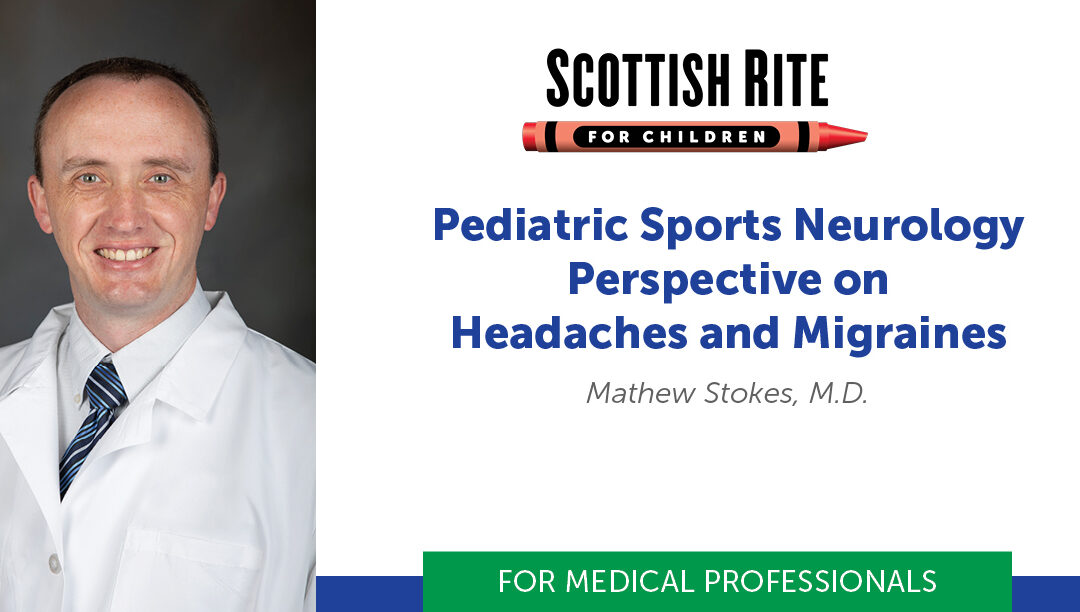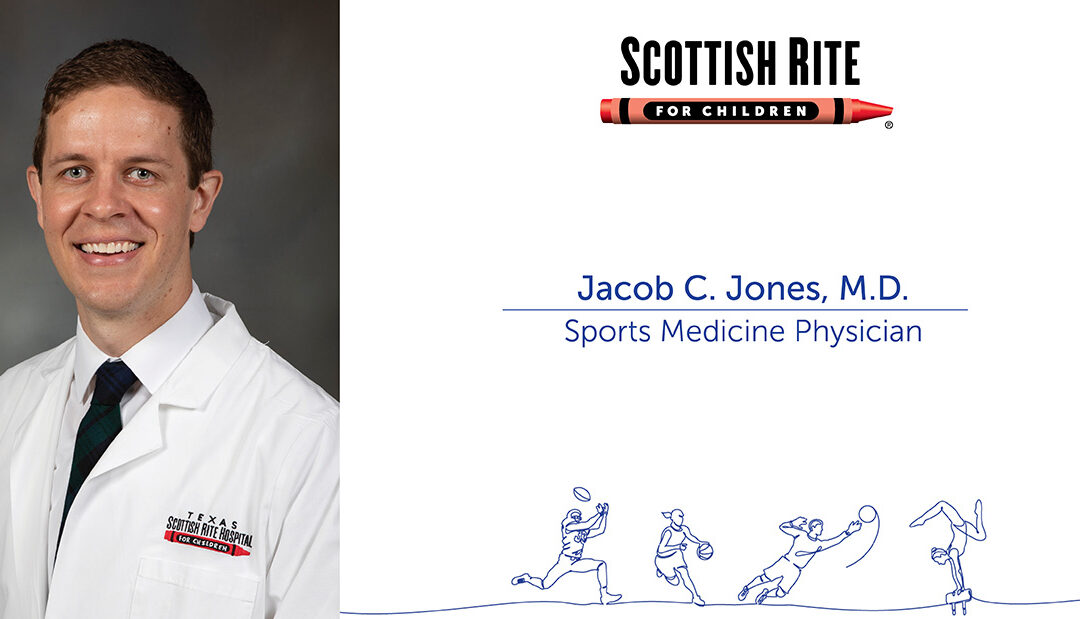
Pediatric Sports Neurology Perspective on Headaches and Migraines
Mathew Stokes, M.D., is a pediatric sports neurologist and headache specialist at UT Southwestern Medical Center and also sees patients at Scottish Rite for Children in Frisco. These resources are designed to help medical professionals recognize and manage sport-related concussions and headaches in children and adolescents.
Sports Neurology: Concussion and Headache in Young Athletes
Mathew Stokes, M.D.
Stokes presented this lecture as part of a monthly education series for medical professionals. He described common symptoms including physical, emotional and cognitive changes associated with sport-related concussion. He presented risk factors associated with delayed recovery from concussion. Finally, he provided criteria for diagnosis, management and prevention of common headache types in athletes including migraines.
Non-Pharmacological Management of Migraines
Victor Kaytser, M.D., and Mathew Stokes, M.D.
Stokes, M.D., co-authored this article with UT Southwestern Medical Center neurology fellow, Victor Kaytser, M.D. The article was originally published in a recent newsletter of the Pediatric Society of Greater Dallas.
Download the PDF of this article.
What Is a Migraine and How Are They Treated?
Migraines are a common neurological disorder affecting one in 10 children, with a higher incidence in teenage girls. (Symptoms of migraine or what is not considered a migraine?)
As we learn more about migraines, we are finding new and innovative ways to treat them. This is especially important for patients who cannot take or do not respond well to the traditionally prescribed pain-relieving and preventive medications. In addition, parents may feel hesitant to medicate their children and will seek non-pharmacological remedies first. Therefore, we will discuss some non-pharmacological options for the treatment of migraines including lifestyle modifications, supplements and devices.
Lifestyle Modifications
Lifestyle modifications are recommended regardless of what other treatments may already be in place and can be remembered using the mnemonic SEEDS: Sleep, Exercise, Eat, Diary, Stress.
Sleep
Migraines can be caused by too much or not enough sleep, and disruptions in the normal 24-hour sleep cycle, or circadian rhythm. Poor sleep habits can trigger migraines, and migraines, in turn, make it difficult to sleep, further exacerbating the pain cycle. A few sleep hygiene tips are as follows:
- Schedule a consistent sleep time and wake time, including weekends.
- Do not use the bed/bedroom for other activities, such as studying, watching TV, etc.
- Avoid staying in bed if wide awake; rise and do something else for a few minutes before trying to fall asleep again.
- Take time outside to help set a natural circadian rhythm.
- Do not exercise before sleep.
- Avoid stimulants, such as caffeine or nicotine.
Exercise
At least 30 minutes of moderate-intensity exercise, three times per week can help reduce migraine frequency and severity. Patients should note that overexertion can worsen headaches. Those involved in contact sports need to be mindful that injuries and head trauma can also worsen headaches.
Eat
Both high and low blood sugar levels can affect migraines. Therefore, eating smaller meals, increasing protein, fiber and healthy fat intake while also reducing processed foods can help maintain healthy glucose levels and reduce migraine frequency.
Maintaining a caffeine-free diet is ideal; however, if patients currently consume caffeine, stopping the consumption suddenly can lead to caffeine-withdrawal headaches. Therefore, a slow weaning of caffeine products is recommended. Other foods that are commonly migraine triggers include aged cheese, chocolate and MSG.
Water intake is also important. The daily goal is one ounce per kilogram of body weight. (1 KG = 2.2 pounds)
Diary
A headache diary can help to identify migraine triggers. Triggers can vary from environmental (e.g., bright lights, weather changes) to nutrition, sleep changes or stressors. Identifying migraine triggers can help patients focus their lifestyle change efforts. Options include Migraine Buddy and iHeadache mobile apps.
Stress
To effectively manage stress, many turn to cognitive behavioral therapy, meditation, mindfulness, massages and yoga. There are free websites, like www.dawnbuse.com, that provide various relaxation audio files, articles and podcasts.
Supplements
Nutraceuticals
Riboflavin (vitamin B2), CoQ10, magnesium, curcumin and feverfew (Tanacetum parthenium) are the most commonly used for migraines. These nutraceuticals have positive effects on mitochondrial metabolism, antioxidant properties and are vasoconstrictors, helping to prevent or relieve pain in migraine sufferers. Several proprietary products, like Migrelief and Dolovent, combine these supplements in a single formula.
Magnesium acts as a calcium channel antagonist and has the most robust body of literature supporting its effects on migraine with a relatively low side effect profile (abdominal discomfort and diarrhea).
Therapies
Essential oils
Peppermint oil contains menthol, which can help ease pain by relaxing the muscles around the head. Rosemary oil has anti-inflammatory and pain-easing characteristics. Lavender and chamomile oil is used to help relax and reduce stress. Eucalyptus oil helps to open and clear the sinuses, which, if congested from allergies, may provoke headaches.
Heating and cooling pads
Placing a hot compress on the neck can help relax tense muscles and relieve pain. A cold compress or ice pack can provide relief through its numbing effect, temporarily dulling the sensation of pain when placed on the neck and/or forehead.
Acupuncture
Used for centuries to treat pain and manage stress, acupuncture has been shown to be at least as effective as some standard drugs like beta blockers and topiramate, and it is safer and more cost effective.
Devices
Medical devices like gammaCore, an external vagus nerve stimulator, can also help. The device is held against the skin of the neck and transmits small electrical currents to stimulate the vagus nerve and block pain signals. The device works in as little as 30 minutes, and 30% of patients were pain-free at two hours. About one-third of patients achieved a 50% reduction in headache frequency.
Nerivio is a neuromodulation device for patients 12 and older, worn on the upper arm to stimulate small nerves that send pain signals to the brain. A third of patients were completely pain-free at two hours.
Cefaly is an external trigeminal nerve stimulation device for patients 18 and older and does not need a prescription. The device is magnetically connected to a reusable self-adhesive electrode that is placed on the center of the forehead and sends micro-impulses to the trigeminal nerve. Studies reported that 32% of patients were pain-free at one hour, and 38% saw at least 50% reduction in migraines per month.
Allay Lamp emits a precise narrow band of green light that helps reduce the light sensitivity associated with migraine, which can also help reduce stress, anxiety and improve sleep.
Conclusion
Helping patients identify migraine triggers and follow daily headache hygiene tips can go a long way in composing an effective treatment plan. In some cases, lifestyle changes may be enough to reduce migraine frequency considerably and avoid the need for devices or medications all together. For others, a combination of lifestyle changes with a device, supplement or medication may be the most effective. For the latest migraine management tips, the American Migraine Foundation website routinely publishes new articles to better manage migraines.

